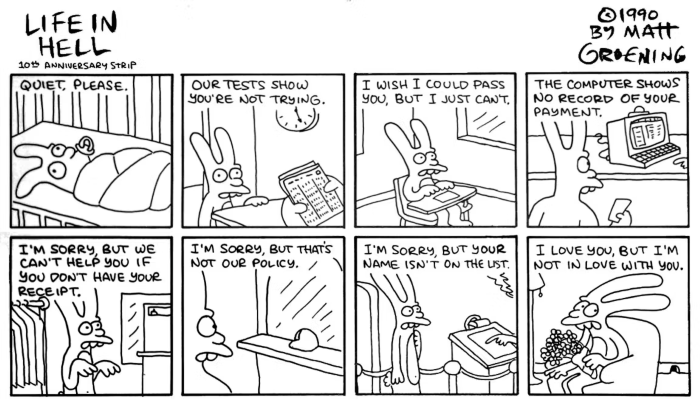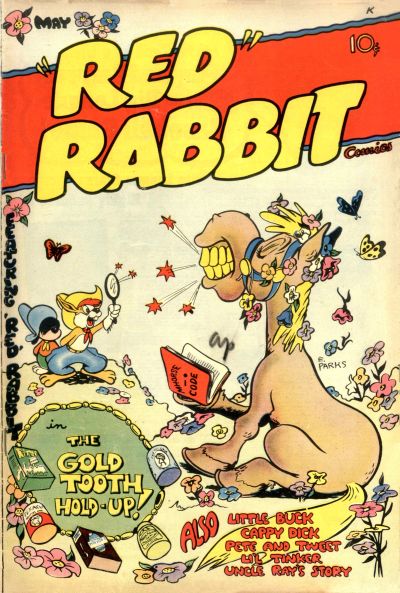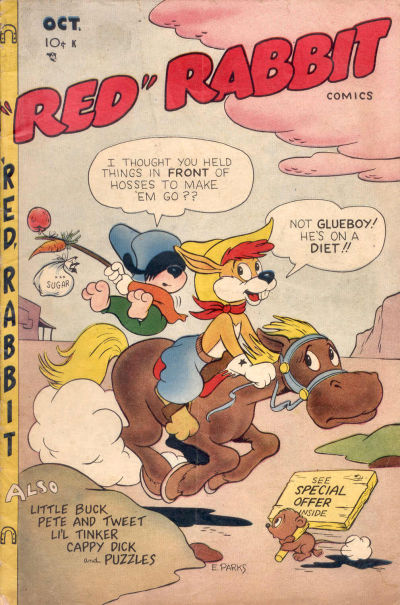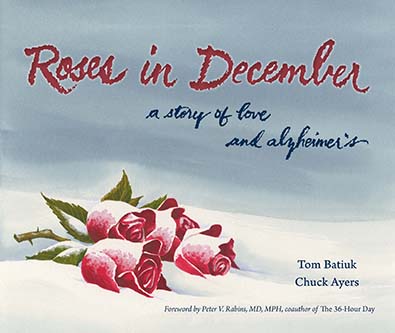Matt Groening and Life in Hell, Bruce Petty and the Vietnam War, Etta Hulme and Comic Books, Art Evans and College Mascots, Carl Jones and The Boondocks, Tom Batiuk and Chuck Ayers and Roses in December.
Before there was Homer, there was Binky

Everyone knows that The Simpsons is what made Matt Groening one of the most iconic names in animation history, but he actually got his start writing a weekly comic strip titled Life in Hell. This comic ran from 1977 to 2012 and, for decades, was the purest way to tap into Groening’s biting, satirical sense of humor. As he made the jumps into mainstream animation, his name would be more often associated with a more accessible, broad style of comedy like in The Simpsons and Futurama, but not with Life in Hell. While funny, it’s also a commentary on the mundanity of life, philosophy, relationships, death, and nihilism, all through the lens of human-sized rabbits and a couple.
**********
How cartoonist Bruce Petty documented the Vietnam War
[Bruce Petty’s] career as a political cartoonist started with a trip to London in the late 1950s, then a stint at young Rupert Murdoch’s afternoon paper in Sydney, the Mirror.
He had a lead role as The Australian’s political cartoonist during the newspaper’s radical first decade, until it turned right during the Whitlam dismissal and Larry Pickering was promoted to favoured cartoonist.
Petty then moved to The Age in its glory days, where he was the acknowledged godfather of the troupe of brilliant cartoonists there at the time.

Robert Phiddian, for The Conversation takes a look at some Bruce Petty cartoons from 1966 and 1967.
Flinders University Museum of Art has a remarkable collection of 73 cartoon originals and sketches from Petty’s most formative period…
Among them are these five particularly vivid cartoons published in The Australian between May 1966 and September 1967…
Petty was in the vanguard of a small but vocal opposition, drawing the war as a deep tragedy for the Vietnamese and a reckless farce perpetrated by the West.
**********
Funny Pages: The Disneyfied Cartoons of Etta Hulme
“One of my more ambitious youthful efforts. Had a pretty good run with it. I was Etta Parks in those days. Sometimes signed myself as just-plain ‘Etta,’ sometimes just ‘E. Parks.’ I had struck out in tryin’ to land some assignments for Mr. Disney’s official Donald Duck funny books, and so I just hauled off and made up some characters of my own. Just as well — I would’ve been forced to sign ‘Walt Disney’ on anything I might’ve done for that company, anyhow.
“And ol’ ‘Red’ Rabbit, now, those funny books gave me good excuse to take off from my Disney-studio experience and combine it with an interest in wild-and-woolly Western adventures.”



Red Rabbit comic book covers via Grand Comic Book Database.
Michael H. Price’s profile of Etta Hulme for Fort Worth Magazine touches on her comic book years.
**********
Arthur Evans, The Man Behind Most of College Football’s Vintage Mascots
Established in 1932 by Hugh Wadel, Junior, the Angelus Pacific Company would eventually make its mark on collegiate sports. Athletic Directors and Bookstore managers would work with the Angelus Pacific Company to design their logos for apparel and merchandising, and those mascots would then appear on shirts and other gear.
But who was the designer responsible for drafting these memorable mascots? That man was Arthur Evans, the lead designer for the Angelus Pacific Company from 1932 to 1977.
KICKS 105 delves into Art Evans career of creating cartoon mascots for colleges.

More about Art Evans from Homefield Apparel.
Picture this: It’s 1963, and you’re checking out a trade advertisement from Angelus. In that ad, they proudly flaunt not just a few but over 100 of their sensational mascot designs. We’re talking about the absolute crème de la crème of college sports icons. From the legendary Duke Blue Devil to the Purdue Boilermaker and the iconic Tommy Trojan of USC—these mascots are the stuff of legend. It was a staggering showcase of power for the company. But what’s even more staggering is to know every design came from one person.
Enter Arthur (Art) Evans.
**********
Carl Jones on Becoming Artist for Boondocks

In this clip, Carl Jones shared his unexpected meeting with Aaron McGruder — comic strip writer and creator of the critically acclaimed show “The Boondocks.” The artist moved to Los Angeles in 2005 and, without prior introduction, encountered McGruder on his first day in the city. The two quickly connected, and McGruder later employed the artist to assist him on his comic strip. Even when faced with challenges, such as meeting tight newspaper deadlines due to McGruder’s late submissions, the pair collaborated effectively. The pair worked together for two years on the comic strip…
It may seem like it’s easy to do a joke a day, but it’s not.
Warning: Carl’s smile is infectious.
**********
The Dying of the Light
People have called me a curmudgeon over the course of my life, and I liked the idea of a comic that was centered around a figure who wasn’t warm and fuzzy. But reading Roses in December [link added], I found myself deeply moved in ways for which I was not prepared. And while it’s easy to say that the reason for that is because it reminded me of real life events, I believe that it’s more than that. The reason why captures some of what a comic strip is capable of doing.

Alex Dueben reviews Roses in December by Tom Batiuk and Chuck Ayers for The Comics Journal.
The storylines collected in Roses in December played out over many years in the Crankshaft strip. One concerns Crankshaft’s best friend, Ralph, whose wife Helen has Alzheimer’s … Over the course of the book we see Ralph spend time with Helen, though she rarely remembers anything about him or their life together … The past is lost to Helen, but [through flashbacks] we’re able to see what is missing.
The other story in the book involves Crankshaft’s aforementioned neighbors, Lucy and Lillian McKenzie, as Lucy is diagnosed with Alzheimer’s. After a series of incidents which range from the dangerous to the humorous, Lucy moves into a home, and later dies.

In case anybody doesn’t recognize RED RABBIT COMICS, it was a Chicago-based publisher (Dearfield) which was owned by none other than Joe Barbera. It’s most famous alumnus was master artist Harvey Eisenberg, who went on to draw nearly twenty years of beautiful TOM & JERRY comics as well as many of the earliest issues of RUFF & REDDY, HUCKLEBERRY HOUND, QUICK DRAW McGRAW and YOGI BEAR, for Dell and Gold Key as well as being a contributing artist to the YOGI BEAR and THE FLINTSTONES comic strips (besides sporadic Disney comics) before passing away in 1965.